Peugeot 308 2017 Owner's Manual
Manufacturer: PEUGEOT, Model Year: 2017, Model line: 308, Model: Peugeot 308 2017Pages: 392, PDF Size: 10.16 MB
Page 271 of 392
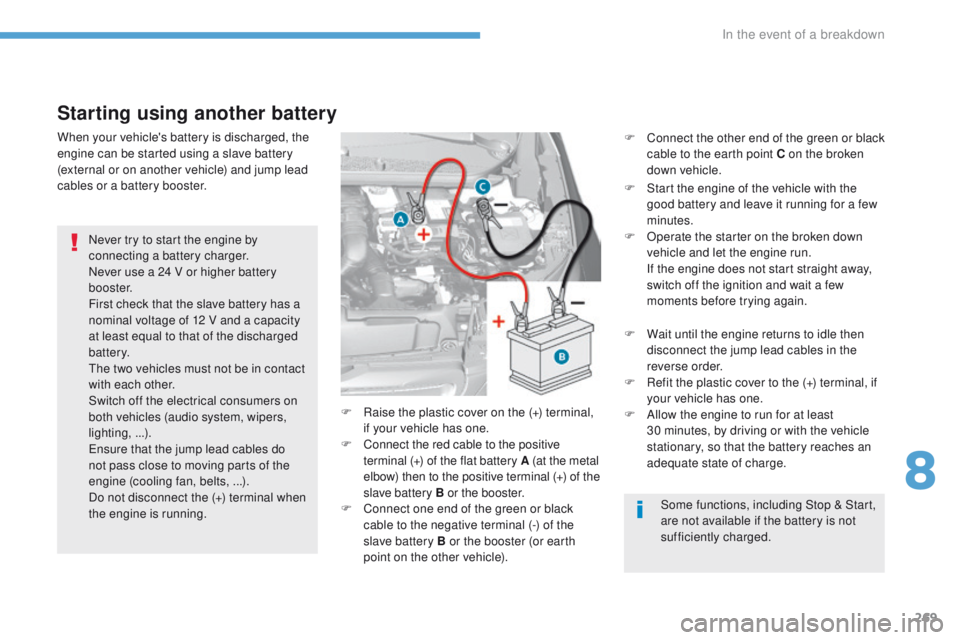
269
308_en_Chap08_en-cas-de-panne_ed01-2016
Starting using another battery
Never try to start the engine by
connecting a battery charger.
Never use a 24 V or higher battery
b o o s t e r.
First check that the slave battery has a
nominal voltage of 12 V and a capacity
at least equal to that of the discharged
battery.
th
e two vehicles must not be in contact
with each other.
Switch off the electrical consumers on
both vehicles (audio system, wipers,
lighting, ...).
en
sure that the jump lead cables do
not pass close to moving parts of the
engine (cooling fan, belts, ...).
Do not disconnect the (+) terminal when
the engine is running. F
R
aise the plastic cover on the (+) terminal,
if your vehicle has one.
F
C
onnect the red cable to the positive
terminal (+) of the flat battery A (at the metal
elbow) then to the positive terminal
(+) of the
slave battery B or the booster.
F
C
onnect one end of the green or black
cable to the negative terminal (-) of the
slave battery B or the booster (or earth
point on the other vehicle).
When your vehicle's battery is discharged, the
engine can be started using a slave battery
(external or on another vehicle) and jump lead
cables or a battery booster.
Some functions, including Stop & Start,
are not available if the battery is not
sufficiently charged.
F
C
onnect the other end of the green or black
cable to the earth point C on the broken
down vehicle.
F
S
tart the engine of the vehicle with the
good battery and leave it running for a few
minutes.
F O perate the starter on the broken down
vehicle and let the engine run.
I
f the engine does not start straight away,
switch off the ignition and wait a few
moments before trying again.
F
W
ait until the engine returns to idle then
disconnect the jump lead cables in the
reverse order.
F
R
efit the plastic cover to the (+) terminal, if
your vehicle has one.
F
A
llow the engine to run for at least
30
minutes, by driving or with the vehicle
stationary, so that the battery reaches an
adequate state of charge.
8
In the event of a breakdown
Page 272 of 392
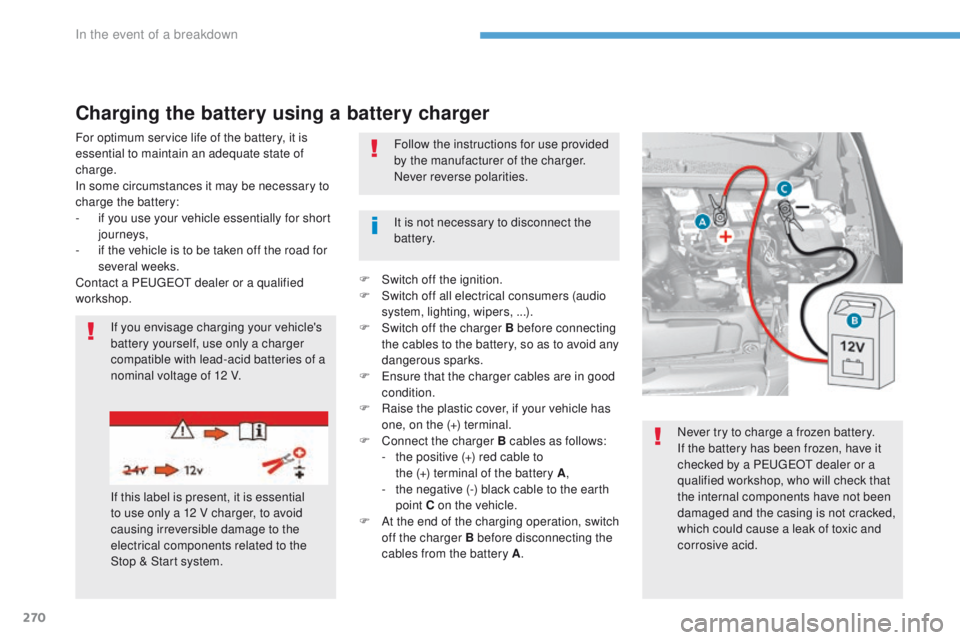
270
308_en_Chap08_en-cas-de-panne_ed01-2016
For optimum service life of the battery, it is
essential to maintain an adequate state of
charge.
In some circumstances it may be necessary to
charge the battery:
-
i
f you use your vehicle essentially for short
journeys,
-
i
f the vehicle is to be taken off the road for
several weeks.
Contact a P
e
uge
Ot
dealer or a qualified
workshop.
Charging the battery using a battery charger
If you envisage charging your vehicle's
battery yourself, use only a charger
compatible with lead-acid batteries of a
nominal voltage of 12 V.
If this label is present, it is essential
to use only a 12 V charger, to avoid
causing irreversible damage to the
electrical components related to the
Stop & Start system. It is not necessary to disconnect the
battery. Follow the instructions for use provided
by the manufacturer of the charger.
Never reverse polarities.
Never try to charge a frozen battery.
If the battery has been frozen, have it
checked by a P
e
uge
Ot
dealer or a
qualified workshop, who will check that
the internal components have not been
damaged and the casing is not cracked,
which could cause a leak of toxic and
corrosive acid.
F
S
witch off the ignition.
F
S
witch off all electrical consumers (audio
system, lighting, wipers, ...).
F S witch off the charger B before connecting
the cables to the battery, so as to avoid any
dangerous sparks.
F
e
n
sure that the charger cables are in good
condition.
F
R
aise the plastic cover, if your vehicle has
one, on the (+) terminal.
F
C
onnect the charger B cables as follows:
-
t
he positive (+) red cable to
the
(+) terminal of the battery A,
-
t
he negative (-) black cable to the earth
point C on the vehicle.
F
A
t the end of the charging operation, switch
off the charger B before disconnecting the
cables from the battery A .
In the event of a breakdown
Page 273 of 392
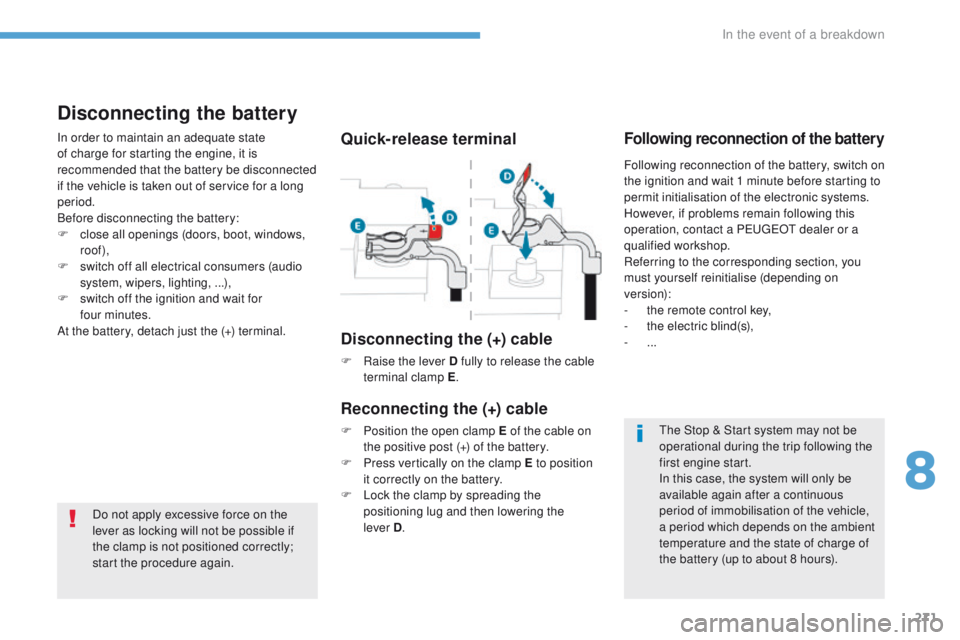
271
308_en_Chap08_en-cas-de-panne_ed01-2016
Do not apply excessive force on the
lever as locking will not be possible if
the clamp is not positioned correctly;
start the procedure again.
th
e Stop & Start system may not be
operational during the trip following the
first engine start.
In this case, the system will only be
available again after a continuous
period of immobilisation of the vehicle,
a period which depends on the ambient
temperature and the state of charge of
the battery (up to about 8 hours).
Quick-release terminal
Disconnecting the (+) cable
F Raise the lever D fully to release the cable terminal clamp E .
Reconnecting the (+) cable
F Position the open clamp E of the cable on
the positive post (+) of the battery.
F
P
ress vertically on the clamp E to position
it correctly on the battery.
F
L
ock the clamp by spreading the
positioning lug and then lowering the
lever
D.
Disconnecting the battery
In order to maintain an adequate state
of charge for starting the engine, it is
recommended that the battery be disconnected
if the vehicle is taken out of service for a long
period.
Before disconnecting the battery:
F
c
lose all openings (doors, boot, windows,
roof),
F
s
witch off all electrical consumers (audio
system, wipers, lighting, ...),
F
s
witch off the ignition and wait for
four
minutes.
At the battery, detach just the (+) terminal.Following reconnection of the battery
Following reconnection of the battery, switch on
the ignition and wait 1 minute before starting to
permit initialisation of the electronic systems.
However, if problems remain following this
operation, contact a P
e
uge
Ot
dealer or a
qualified workshop.
Referring to the corresponding section, you
must yourself reinitialise (depending on
version):
-
t
he remote control key,
-
t
he electric blind(s),
-
...
8
In the event of a breakdown
Page 274 of 392
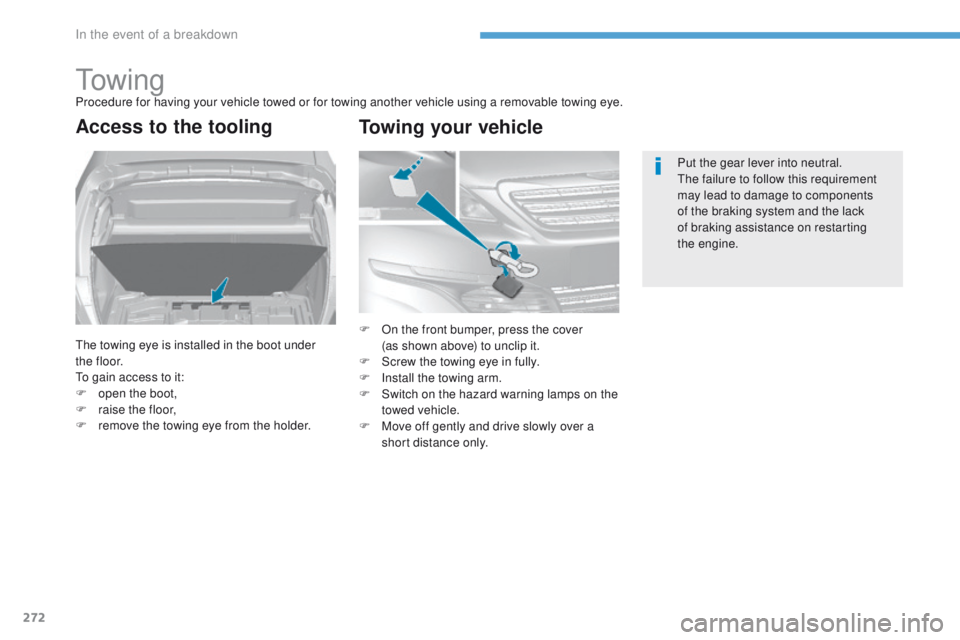
272
308_en_Chap08_en-cas-de-panne_ed01-2016
to w i n gProcedure for having your vehicle towed or for towing another vehicle using a removable towing eye.
Access to the tooling
the towing eye is installed in the boot under
t h e f l o o r.
to g
ain access to it:
F
o
pen the boot,
F
r
aise the floor,
F
r
emove the towing eye from the holder. Put the gear lever into neutral.
th
e failure to follow this requirement
may lead to damage to components
of the braking system and the lack
of braking assistance on restarting
the
engine.
F O n the front bumper, press the cover
(as shown above) to unclip it.
F
S
crew the towing eye in fully.
F
I
nstall the towing arm.
F
S
witch on the hazard warning lamps on the
towed vehicle.
F
M
ove off gently and drive slowly over a
short distance only.
Towing your vehicle
In the event of a breakdown
Page 275 of 392
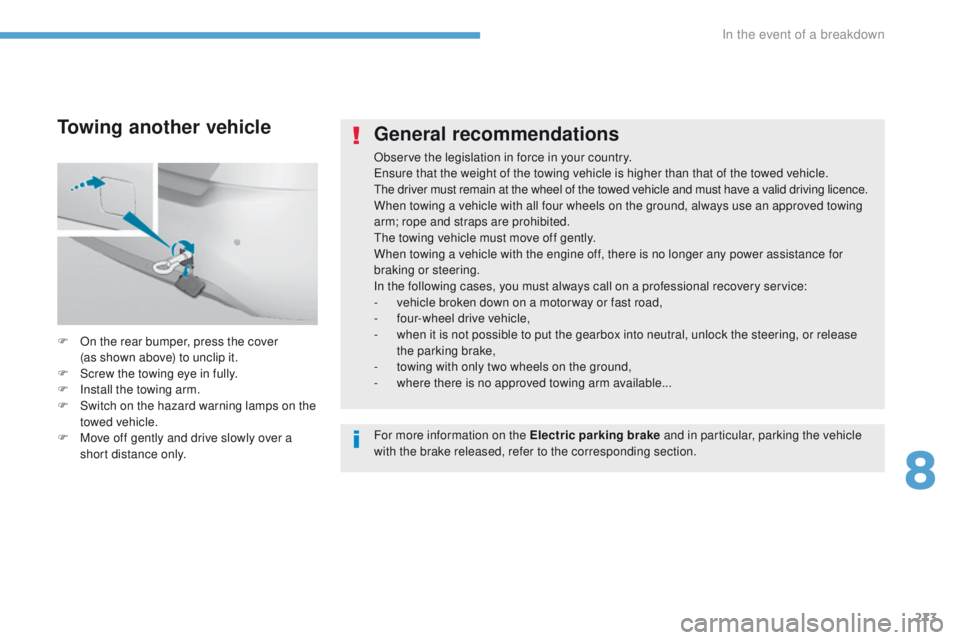
273
308_en_Chap08_en-cas-de-panne_ed01-2016
General recommendations
Observe the legislation in force in your country.en
sure that the weight of the towing vehicle is higher than that of the towed vehicle.
th
e driver must remain at the wheel of the towed vehicle and must have a valid driving licence.
When towing a vehicle with all four wheels on the ground, always use an approved towing
arm; rope and straps are prohibited.
th
e towing vehicle must move off gently.
When towing a vehicle with the engine off, there is no longer any power assistance for
braking or steering.
In the following cases, you must always call on a professional recovery service:
-
v
ehicle broken down on a motor way or fast road,
-
f
our-wheel drive vehicle,
-
w
hen it is not possible to put the gearbox into neutral, unlock the steering, or release
the parking brake,
-
t
owing with only two wheels on the ground,
-
w
here there is no approved towing arm available...
F
O
n the rear bumper, press the cover
(as
shown above) to unclip it.
F
S
crew the towing eye in fully.
F
I
nstall the towing arm.
F
S
witch on the hazard warning lamps on the
towed vehicle.
F
M
ove off gently and drive slowly over a
short distance only.
Towing another vehicle
For more information on the Electric parking brake and in particular, parking the vehicle
with the brake released, refer to the corresponding section.
8
In the event of a breakdown
Page 276 of 392
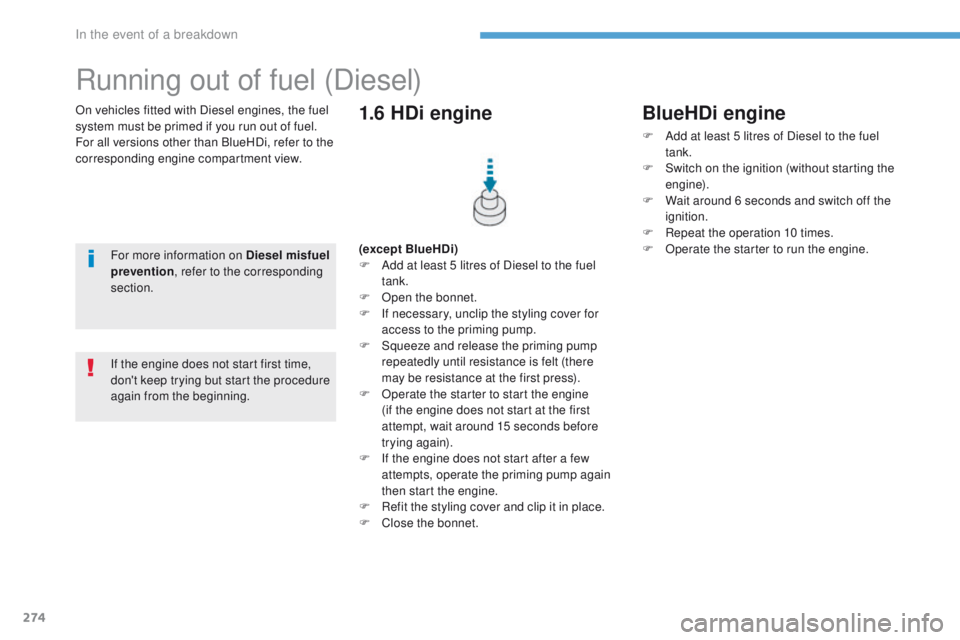
274
308_en_Chap08_en-cas-de-panne_ed01-2016
On vehicles fitted with Diesel engines, the fuel
system must be primed if you run out of fuel.
For all versions other than BlueHDi, refer to the
corresponding engine compartment view.
Running out of fuel (Diesel)
For more information on Diesel misfuel
prevention , refer to the corresponding
section. (except BlueHDi)
F
A dd at least 5 litres of Diesel to the fuel
tank.
F
O
pen the bonnet.
F
I
f necessary, unclip the styling cover for
access to the priming pump.
F
S
queeze and release the priming pump
repeatedly until resistance is felt (there
may be resistance at the first press).
F
O
perate the starter to start the engine
(if the engine does not start at the first
attempt, wait around 15 seconds before
trying again).
F
I
f the engine does not start after a few
attempts, operate the priming pump again
then start the engine.
F
R
efit the styling cover and clip it in place.
F
C
lose the bonnet.
1.6 HDi engine
If the engine does not start first time,
don't keep trying but start the procedure
again from the beginning.
BlueHDi engine
F Add at least 5 litres of Diesel to the fuel tank.
F
S
witch on the ignition (without starting the
engine).
F
W
ait around 6 seconds and switch off the
ignition.
F
R
epeat the operation 10 times.
F
O
perate the starter to run the engine.
In the event of a breakdown
Page 277 of 392
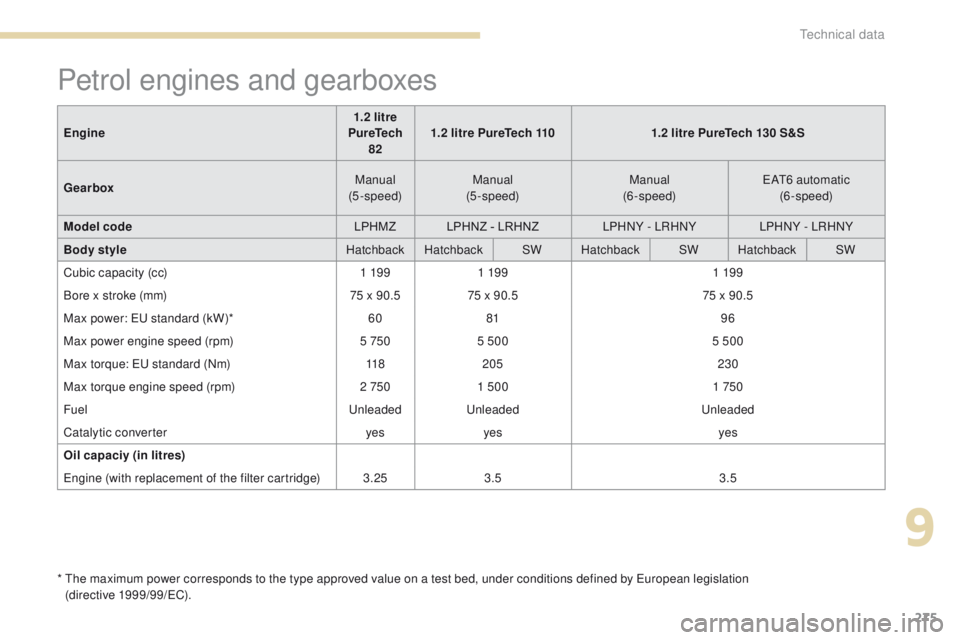
275
308_en_Chap09_caracteristiques-techniques_ed01-2016
Petrol engines and gearboxes
* the maximum power corresponds to the type approved value on a test bed, under conditions defined by eu ropean legislation
(directive 1999/99/eC ).
Engine
1.2 litre
PureTech 82 1.2 litre PureTech 110
1.2 litre PureTech 130 S&S
Gearbox Manual
(5-speed) Manual
(5-speed) Manual
(6-speed)
eAt6
automatic
(6-speed)
Model code LPHMZLPHNZ - LRHNZ LPHNY - LRHNY LPHNY - LRHNY
Body style Hatchback HatchbackSWHatchback SWHatchback SW
Cubic capacity (cc) 1 19 91 19 9 1 19 9
Bore x stroke (mm) 75 x 90.575 x 90.5 75 x 90.5
Max power: eu standard (kW)*
6081 96
Max power engine speed (rpm) 5 7505 500 5 500
Max torque: eu standard (Nm)
118205 230
Max torque engine speed (rpm) 2 7501 500 1 750
Fuel
u
nleaded
u
nleaded
u
nleaded
Catalytic converter yesyes yes
Oil capaciy (in litres)
en
gine (with replacement of the filter cartridge)
3.253.5 3.5
9
technical data
Page 278 of 392
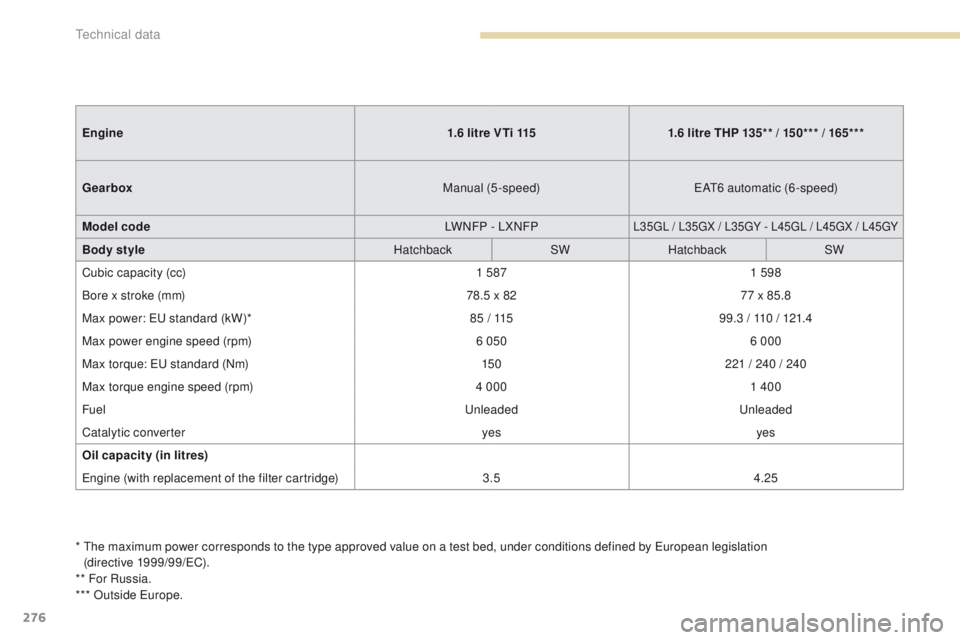
276
308_en_Chap09_caracteristiques-techniques_ed01-2016
* the maximum power corresponds to the type approved value on a test bed, under conditions defined by eu ropean legislation
(directive 1999/99/eC ).
** For Russia.
*** Outside
e
u
rope.
Engine
1.6 litre VTi 1151.6 litre THP 135** / 150*** / 165***
Gearbox Manual (5-speed)
eAt6
automatic (6-speed)
Model code LWNFP - LXNFP
L35gL / L35gX / L35gY - L 45gL / L 45gX / L 45gY
Body style HatchbackSWHatchback SW
Cubic capacity (cc) 1 5871 598
Bore x stroke (mm) 78.5 x 8277 x 85.8
Max power:
eu standard (kW)* 85 / 11599.3 / 110 / 121.4
Max power engine speed (rpm) 6 0506 000
Max torque:
eu standard (Nm) 150221 / 240 / 240
Max torque engine speed (rpm) 4 0001 400
Fuel
u
nleaded
u
nleaded
Catalytic converter yesyes
Oil capacity (in litres)
en
gine (with replacement of the filter cartridge) 3.54.25
technical data
Page 279 of 392
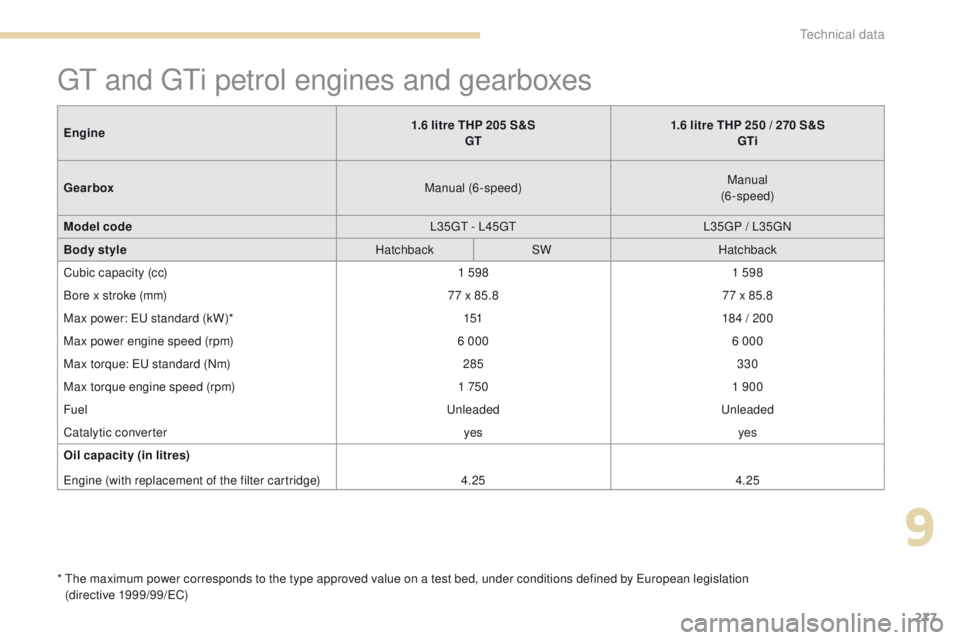
277
308_en_Chap09_caracteristiques-techniques_ed01-2016
gt and gti petrol engines and gearboxes
* the maximum power corresponds to the type approved value on a test bed, under conditions defined by eu ropean legislation
(directive 1999/99/eC )
Engine
1.6 litre THP 205 S&S
GT 1.6 litre THP 250 / 270 S&S
GTi
Gearbox Manual (6-speed)Manual
(6-speed)
Model code L35
gt -
L45
gtL
35
gP / L
35
gN
B
ody style
HatchbackSW Hatchback
Cubic capacity (cc) 1 5981 598
Bore x stroke (mm) 77 x 85.877 x 85.8
Max power: eu standard (kW)*
151184 / 200
Max power engine speed (rpm) 6 0006 000
Max torque: eu standard (Nm)
285330
Max torque engine speed (rpm) 1 7501 900
Fuel
u
nleaded
u
nleaded
Catalytic converter yesyes
Oil capacity (in litres)
en
gine (with replacement of the filter cartridge)
4.254.25
9
technical data
Page 280 of 392
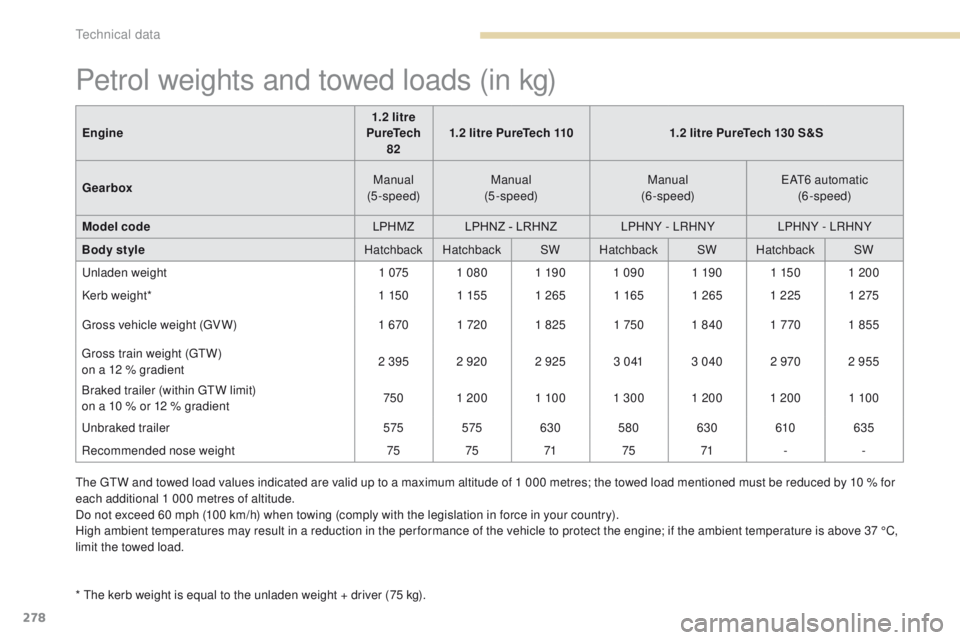
278
308_en_Chap09_caracteristiques-techniques_ed01-2016
Petrol weights and towed loads (in kg)
* the kerb weight is equal to the unladen weight + driver (75 kg).Engine
1.2 litre
PureTech 82 1.2 litre PureTech 110
1.2 litre PureTech 130 S&S
Gearbox Manual
(5-speed) Manual
(5-speed) Manual
(6-speed)
eAt6
automatic
(6-speed)
Model code LPHMZLPHNZ - LRHNZ LPHNY - LRHNY LPHNY - LRHNY
Body style Hatchback HatchbackSWHatchback SWHatchback SW
un
laden weight
1 0751 080 1 19 01 090 1 19 01 1501 200
Kerb weight* 1 150 1 1551 2651 1651 265 1 225 1 275
gr
oss vehicle weight (
gV
W)
1 6701 720 1 825 1 7501 840 1 7701 855
gr
oss train weight (
g
t
W
)
on a 12 % gradient 2 395 2 920 2 925
3 0 413 040 2 9702 955
Braked trailer (within gt
W l
imit)
on a 10 % or 12 % gradient 750
1 200 1 10 01 300 1 200 1 200 1 10 0
unb
raked trailer
575 575630580 630 610635
Recommended nose weight 7575 7175 71 --
th
e gt
W a
nd towed load values indicated are valid up to a maximum altitude of 1 000 metres; the towed load mentioned must be reduced by 10 % for
each additional 1 000 metres of altitude.
Do not exceed 60 mph (100 km/h) when towing (comply with the legislation in force in your country).
High ambient temperatures may result in a reduction in the per formance of the vehicle to protect the engine; if the ambient temperature is above 37 °C,
limit the towed load.
technical data